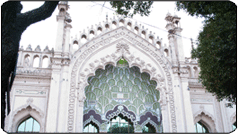Jama Masjid
Jame means a large congregation and the name Jame or Jama Masjid implies that the mosque is meant for large congregation for the afternoon prayer on Fridays and with its large capacity it may also be used for the mass prayers on the festival of Id {Id-ul-Fitr) and Baqrid (Id-uz-Zuha). The large mosque with tall minarets extant towards south-west of Hussainabad Imambara still continues to have Jama Masjid as its name which is actually a misnomer. In fact, this grand mosque built at the behest of the third King of Awadh, Mohammed Ali Shah (1837-1842) and intended to be the largest in this part of the country has been used as the Friday mosque of the Shia sect for a very brief period (1842-1857). It was never the Jame Masjid in the real sense after the freedom struggle began in 1857, when the venue of the Namaaz-e-Juma (Friday prayers) was shifted to Tehsin ki Masjid near the Akbari Darwaza in the old city [since residents of Hussainabad and other areas near the riverside had been forced to vacate by the British and they had to flee to safety to other parts of the city].
Interestingly, controversy arose even when the King wanted to begin the namaaz in 1842, when the mosque had been partly built. Mohammed Ali Shah invited the Shia chief priest titled Sultan-ul-Ulema, Syed Mohammed (1784-1867), the son of Ghufran maab, Syed Dildar Ali Naqvi of Naseerabad (near Jais) to lead the prayers. He refused outright saying that the prayers could not be offered at a place which was disputed. He explained that a part of the land on which the mosque was being built belonged to one Naeem Khan and there was a dispute regarding the amount of payment to be made to the owner of the land which he had not received. According to the Fiqah-e-Jafri (Shia jurisprudence) a mosque cannot be built on a disputed site and it was improper to offer prayers therein till the matter of payment was resolved satisfactorily. The King regretted the matter and requested Sultan-ul-Ulema to resolve it amicably, which the latter did, to the satisfaction of both the subject, the landowner and the ruler. It was thereafter that the first congregation for offering the Friday prayers was held in this mosque in 1842. Earlier this congregation used to be held in the Asafi mosque (in the Bara Imambara complex) built by Nawab Asaf-ud-Daulah.
At the age of sixty-eight, after a brief rule of five years, Mohammed Ali Shah expired but not before making a provision of rupees ten lakh with his wife Malka Jahan to complete the construction of the Jama Masjid. Despite further construction the mosque remains incomplete, yet majestic, as is evident from the two partly built (and incomplete) minarets of the western side.
The central archway leading to the two prayer halls of the mosque is a copy of the western side of the Rumi Darwaza, with a combination of double cusped arches and a weaving of intersecting arcs that form a honeycomb pattern at the squinch. The high ceiling and pillars inside the prayer halls are tastefully decorated with foliage and flowers fashioned in stucco. The Mehraab (prayer niche) facing the west has calligraphic inscriptions of Quranic verses alongwith decorative stucco work.
A staircase on the south-east corner of the first hall leads to the roof-top, from where the visitor may closely observe the stucco patterns on the large gumbad (domes) and balustrades of the mosque. A staircase within the minarets leads to the stone chhattri(umbrella) placed on the top. Being at a height, one gets a bird-eye view of adjoining Hussainabad and other areas of the old city from the chhattri.
In the second prayer hall, just as it is provided in the Asafi Masjid, the place for the Pesh Imam (leader of the prayer) is provided in the hollow of the floor, so that during the mass, he does not stand above any of his followers, who may be standing at the ground level when the congregation overflows because of a gathering larger* than the capacity of the mosque. According to the Shia discipline, the Imam should not stand above his followers at prayers.
The Jama Masjid was surrounded by a walled boundary which had a lofty gateway, but all that was demolished by the British in the struggle of 1857-58, along with the nearby residential buildings that were bombarded.
Source:
Hindustan Times, City Scan, A Time in History
Wednesday 14.1.1998 — A brief tryst with fame

